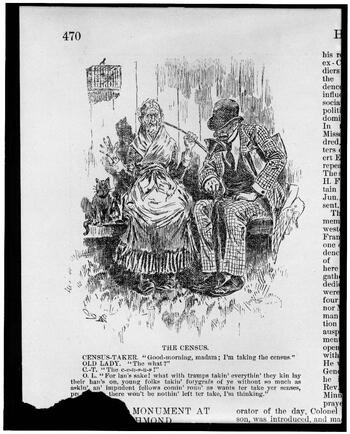The 1840 Census included “Name and age of pensioners for Revolutionary or military service,” as well as additional questions pertaining to numbers of persons, “White” and “Colored” who were “blind,” “insane and idiots,” and “deaf, dumb and blind,” as well as “White persons age 20 years and older who could not read and write.” This Census was also counting numbers of educational institutions in the country, both primary and secondary, as well as the numbers of students associated with each institution. In March 1840, a census board was created consisting of the Secretary of State, Attorney-General, and Postmaster General and, and was to operate under the direction of the newly established Department of the Interior.
The 1900 report observes this census saw the beginning of the government’s interest in using the census as a means of providing a more detailed reflection of the growth and development of the country with respect to its “industries and resources.” This was also the first time a reference was made to ascertaining more reliable data, even referenced in President Van Buren’s inaugural speech. Congress received many “memorials” from different organization at the time, complaining of the gross errors and discrepancies discovered. Among these came one from the American Statistical Association in 1843, decrying some marshal’s returns indicating they had placed entire households under the occupation given for the head of household and most glaring, the “remarkable errors are found in the statements respecting nosology, the prevalence of insanity, blindness, deafness and dumbness among the people of this nation.” The memorialists noting that in many towns, all the colored population are stated to be insane. Congress recognized the errors and admitted of them. The root cause was attributed to the fact that the growing population and geography of the country was making the task exceedingly difficult with limited resources; marshals and their assistants were not often properly supervised and sorely underpaid; they lacked any kind of support from the government in the ways of supplies and materials, and the census itself was not a permanent office of government.
Cartoon showing man taking census from old woman, who thinks he wants to take her senses, 1890. Source: Library of Congress.
Report of the Census to the U.S. Secretary of the Interior, 1901. Source: US Census Bureau.
